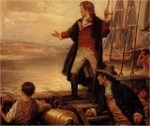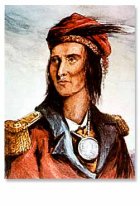
Worksheets and No Prep Teaching Resources
Reading Comprehension Worksheets
A New Nation
(1776-1830)

A New Nation
(1776-1830)
 Worksheets and No Prep Teaching Resources Reading Comprehension Worksheets A New Nation (1776-1830) |
 A New Nation (1776-1830) |
| edHelper's suggested reading level: | grades 6 to 8 | |
| Flesch-Kincaid grade level: | 6.74 |
|
Tecumseh and the Native American Alliance
By Jane Runyon |

|
 1 Tecumseh was born into the Shawnee tribe in the spring of 1768. His father was a chief of the tribe which made its home in what is now Ohio. Just as he was born, a brilliant shooting star could be seen overhead by his father. The chief believed that this was a sign of good fortune. The baby was given the Shawnee name Tekamthi which means "The Panther Passing Across." They believed that a shooting star was their Great Spirit in the form of a panther. Tekamthi had a brother called Tenskwatawa. As they grew older, Tenskwatawa became a religious leader of the tribe called a shaman (SHAY mun). His people called him a prophet. Tekamthi grew to be a strong and respected leader of the Shawnee people. Tekamthi learned English from a white boy who was adopted into the tribe. He met white people like Daniel Boone. He learned to respect white men like Boone. He also learned to hate white men. His father was killed while fighting with the white men to keep the Shawnee land. His mother and other members of the tribe had been forced to flee their home in Ohio and move farther west. The white men were moving into Indian Territory and forcing the natives out.
1 Tecumseh was born into the Shawnee tribe in the spring of 1768. His father was a chief of the tribe which made its home in what is now Ohio. Just as he was born, a brilliant shooting star could be seen overhead by his father. The chief believed that this was a sign of good fortune. The baby was given the Shawnee name Tekamthi which means "The Panther Passing Across." They believed that a shooting star was their Great Spirit in the form of a panther. Tekamthi had a brother called Tenskwatawa. As they grew older, Tenskwatawa became a religious leader of the tribe called a shaman (SHAY mun). His people called him a prophet. Tekamthi grew to be a strong and respected leader of the Shawnee people. Tekamthi learned English from a white boy who was adopted into the tribe. He met white people like Daniel Boone. He learned to respect white men like Boone. He also learned to hate white men. His father was killed while fighting with the white men to keep the Shawnee land. His mother and other members of the tribe had been forced to flee their home in Ohio and move farther west. The white men were moving into Indian Territory and forcing the natives out. |
Create Weekly Reading Books
Prepare for an entire week at once! |
| Leave your feedback on Tecumseh and the Native American Alliance (use this link if you found an error in the story) |
 |
A New Nation (1776-1830) |
 |
United States
|
|
|
 | Fifty States Theme Unit |
 |
Document Based Activities |